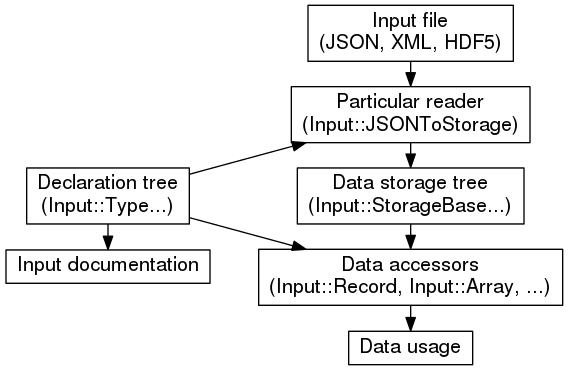
|
Modules | |
| Input Accessors | |
| Input Types | |
Classes | |
| class | Input::JSONToStorage |
| Reader for (slightly) modified JSON files. More... | |
| class | Input::StorageBase |
| Base class for nodes of a data storage tree. More... | |
Detailed Description
Overview of data input classes
We assume that the input data of the program can be represented by a tree. The leave nodes of the tree contain actual data and has one of the 'scalar' types represented by the classes in Input::Type namespace : Bool, Integer, Double, String, and FileName. The branching nodes of the input tree can be either of type Array or type Record (or AbstractRecord). Classes derived from Input::Type::TypeBase only describes structure of the input tree which is independent of actual format of the input data.
Instances of the classes from the Input::Type namespace form a declaration-tree that is later used by a reader of the particular file format (currently we support only JSON through the Input::JSONToStorage reader) to interpret the input data, check its structure, possibly use default values and put the raw data into an intermediate storage-tree formed be Input:Storage classes.
Finally, the data are accessible through accessors Input::Record, Input::Array, and Input::AbstractRecord. These accessors holds pointers into declaration tree as well as into the data storage tree and provides unified access to the data.
Furthermore, the declaration-tree can output itself provided a basic documentation of the input data structure, that is consistent with the actual state.
Here is simple scheme of information exchange between classes:

Practical usage
In order to use input interface you have to create declaration-tree, namely Selection, Record, and AbstractRecord types has to be declared by specification of its keys. We suggest to have a static method that returns Input::Type::Record for ever class which is initialized from input interface. Example of usage follows:
The accessor for the root Input::Record is provided by the reader class ( JSONToStorage.get_root_interface<>() )
 1.8.5
1.8.5